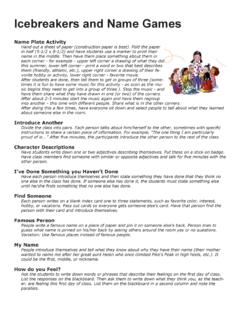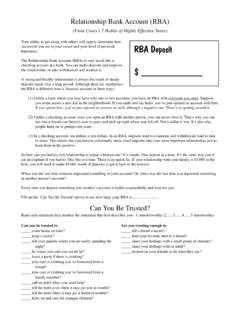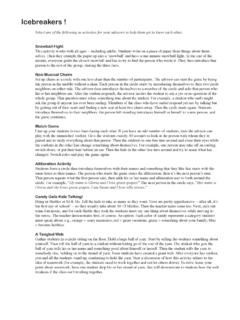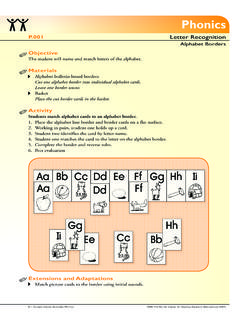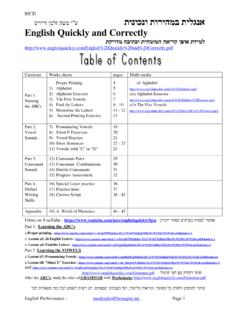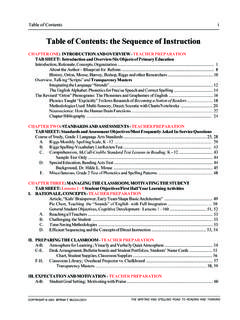Transcription of Tolerance - Minnesota Middle School Association
1 ToleranceOverview Tolerance of those who may be different from you or have a different point of view is a character trait of very high value. As stated by Dr. Martin Luther King I have a dream that my four children will one day live in a nation where they will not be judged by the color of their skin but by the content of their character. Print off the Tolerance poster and place it in your room for reference during this / Handouts Tolerance of the Hearing Impaired - Run off these sheets and cut them in half before setting up students in pairs. Some introduction in the trouble people face (even young people) who are hearing impaired will help with this activ-ity. Drinking Straws Galore - An activity that simulates various disabilities trying to accomplish tasks. The Wrinkled Heart - As you read the story begin to crumple the paper each time the boy had something negative said to him.
2 As positive remarks came his way, unfold the paper and try to smooth it out. Tell students that saying things to others in a hurtful way is difficult to undo, no matter how much you try. Left Out - The activity gets the kids moving around the room trying to join up with another group without being left out. This might be a good activity to try after the video on Wednesday. Tolerance Paired Activity - Print and cut the paper in two pieces for this activity using the Venn Diagram. Students who see more connections with each other are more tolerant of their differences. Group Benefits - An activity where student s differences are an advantage to answering questions. Goldilocks and the Three Bears - An activity to challenge student s ability to listen to each other in a collective reading of the story. Students who are unable to read with fluency may need to opt out of this challenge.
3 Human Bingo - Students need to answer the questions before doing the activity - use about 5-10 minutes. The cen-ter box Stupid Human Trick is anything a student can do that is unique or unusual ( dislocate finger) Alphabet Search - A quick activity to see how resourceful students can be in naming items they are wearing or have with them. Stretch / Scrunchie - A couple of activities to challenge another advisory. More Activities - A number of activities that will help building relationships within your TOLerAnT MeAnS: Learning to appreciate and enjoy people who are different than you. Taking a stand when someone is being intolerant. (Example: being a bully) Accepting that others don t think the way you do. Not making negative comments about others ethnic back-grounds, beliefs, or YOur Tolerance BY: Avoiding judgments based on how others dress or talk.
4 Using positive words to describe people. Trying to understand other s points of view. Meeting new people and looking for things you have in common. I have a dream that my fourchildren will one day live in anation where they will not bejudged by the color of their skin butby the content of their character. Martin Luther King, Wrinkled HeartOne morning, a small boy woke up and started his day. He got dressed by himself, put on his own shoes and even started brushing his teeth without be-ing asked! He was having a great there was water on the floor, water on the mirror, water on the counter but he was brushing his teeth by himself! It was a hectic morning and when the boy s mother came in and saw the water, she scolded him for the and the boy s heart crumpled a little bit. The small boy bounced downstairs, determined to have a good day.
5 He saw the cereal and milk on the table and decided to fix his own bowl. But the milk carton was a bit heavy, and the milk spilled onto the table. The boy s father was trying to read the paper and when he saw what had happened, he told the boy that he was clumsy. The small boy s heart crumpled some more. It was the first day of School for the boy. When he boarded the bus, the driver (who wanted to be at home) told him his new socks looked silly. Need-less to say, the boy s heart crumpled. When he went to class, the boy realized he didn t have his milk money. When he told the teacher that he forgot, she threw up her hands in exasperation and said he d just have to skip milk time today. The boy s heart was all crumpled up. Tomorrow is anew day for the boy. When tomorrow came, the boy went to brush is teeth. When his mother came in, she gave him some towels and asked him to please wipe the counter when he was finished, and she showed him a spe-cial place for his toothbrush and paste.
6 The boy s heart unwrinkled a little. When the boy went downstairs for breakfast, the milk spilled again. The boy s father gave him a sponge to wipe the spill and poured some milk into a more manage-able pitcher for the boy. The boy s heart felt better! When the boy got on the School bus, the driver told him what neat pants he had on. The boy s heart was smoothing out. Today was only the second day of School and the boy remembered his lunch but he forgot his milk money again. The teacher told the boy that everyone forgets things sometimes and she would find a way to help him remember. The boy s heart felt pretty good. But the boy s heart wasn t as smooth as it used to be. It still had some creases and wrinkles from being all crumpled up. It takes a long time to smooth those wrinkles. LEFT OUT Overview:There are very few situations in a young person s life that are more traumatic than being left out of the in group , whatever that is at the moment.
7 The wanting to belong is so strong that we see kids getting mixed up with groups that they may not really want to be a part of, but they are desperate to be a part of something. This may be where some of the interest in gangs has come from in recent years. This activity addresses the problem from the person s point of view who is on the outside looking in. Activity: (Musical chairs without the music and the chairs)Have the entire class stand up. Explain that the object of this activity will be to follow the commands you give. You will call out a number and they will have to form themselves into groups that are made up of that number. For the first few times let them practice and see how fast they can do it. If there are any people left over after the groups have been formed, they are to just stand still and jump back in the game during the next command.
8 As an example, you will call out the number 3 . Everyone in the group has to find two partners and form a group of three people. Give them only about three to five seconds to find a group. Then you might call out five, no one may stay in the same group so everyone goes looking for a new group of five people. After a few practice rounds, explain that from now on if you do not get into a group then you must go to the side and stand. These people are out of the game. The game continues until you have only a few people left and you call out the number 2 . Someone loses and the couples that are left are the winners. It is recommended that you play this elimination round through at least twice before you Ideas: Was there anything hard about this activity? What was it? How did you feel when you were not able to join a group and were out of the game?
9 What words can we use to describe these feelings? How easy was it to keep finding a new group to join every time a new number was called out? What is a clique? What can this activity teach us about cliques? Are cliques bad or good? Explain. Describe the different groups that are found in your School . How do some people feel when they are not in a group? Does everyone want to be a part of a group? Explain. What are the advantages of being in a group? Are certain groups stereotyped as to how they act? Tolerance Paired ActivityPair up with someone in your advisory who you don t know very well. Using the Venn Diagram, identify three things that you have in common and three things that are Paired ActivityPair up with someone in your advisory who you don t know very well. Using the Venn Diagram, identify three things that you have in common and three things that are BeneFITS Topic: Tolerance , Diversity, Working TogetherOverview:No one individual knows everything.
10 Some people might think and act like they do, but in reality everyone is experienced in different areas due to their background, heritage, interests and abilities. When we look at a community we will see a melt-ing of those experiences reflected in the values of that community. Individuals influence those groups to which they belong and then those groups influence the community has a whole. Each group may add something different. Without each group s contribution, communities and the workplace would lose the richness that comes with diversity. Working together to produce a thriving community, profitable product or a successful concept happens when we accept not just the contributions of one or two individuals but the thoughts and suggestions of many people. A group can improve their work through the use of syn-ergy, while an individual must use more energy to get the same result.

